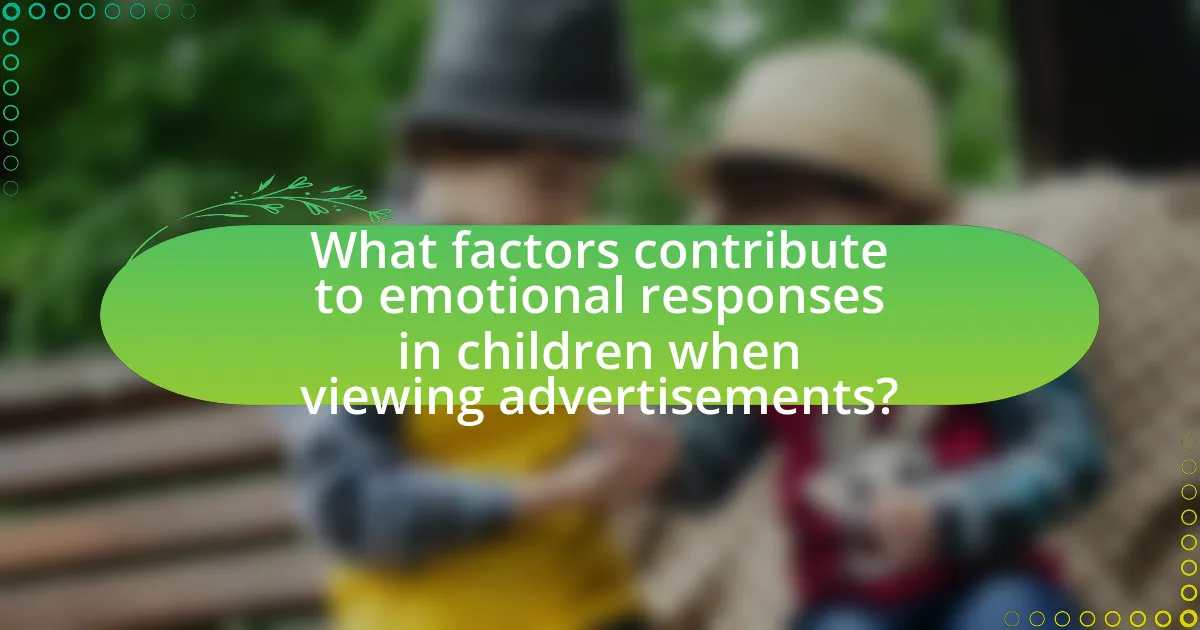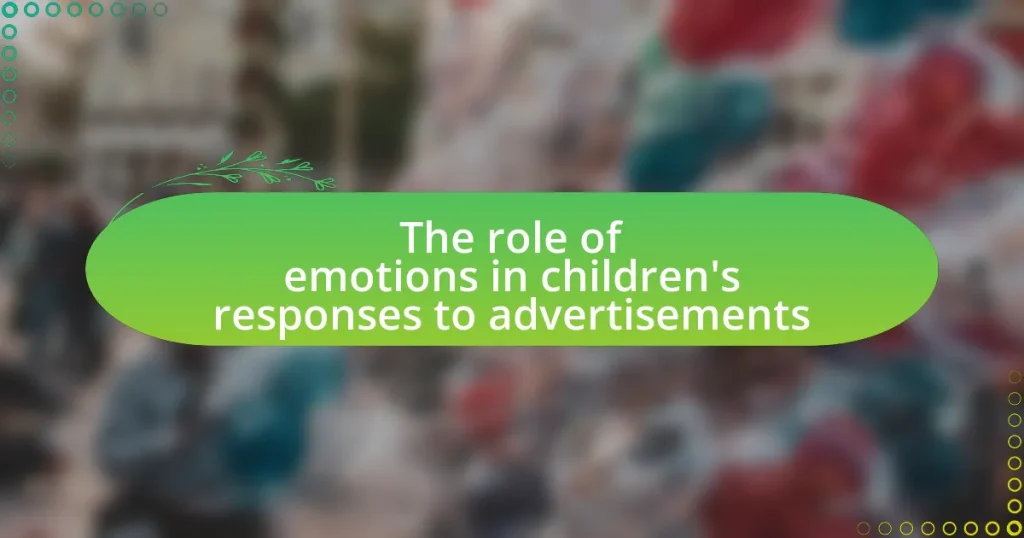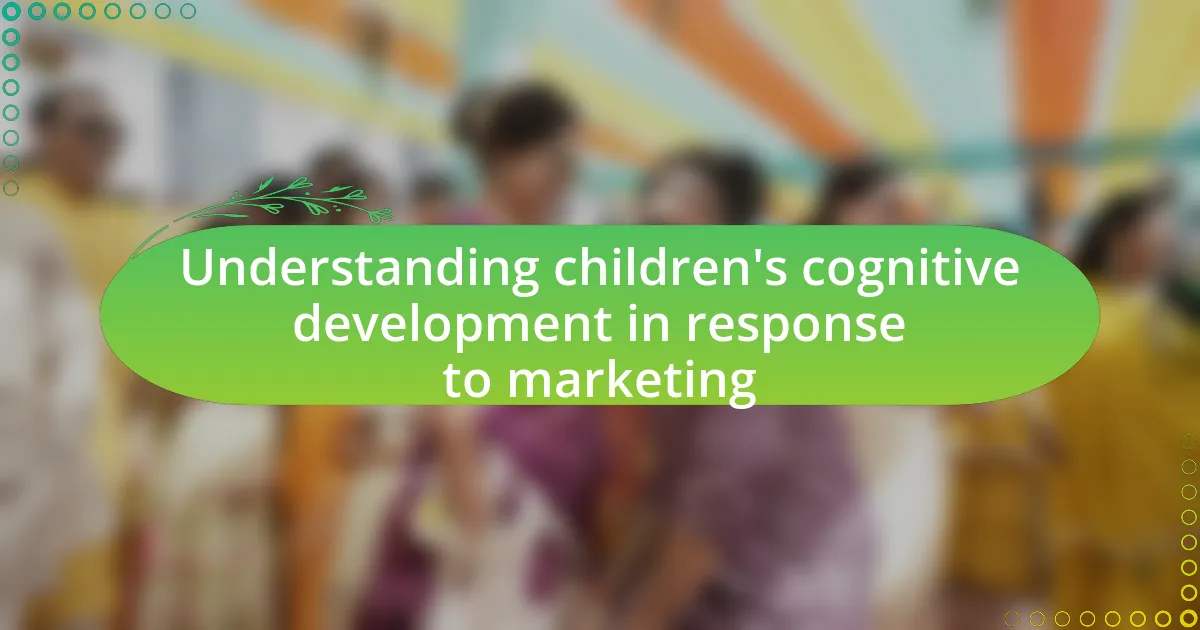The article examines the significant role of emotions in children’s responses to advertisements, highlighting how emotional engagement influences their attention, memory, and purchasing behavior. It discusses various emotions commonly triggered by advertisements, such as joy and excitement, and how these emotions affect children’s perception and understanding of marketing messages. Additionally, the article explores the impact of age, cognitive development, and cultural background on emotional responses, as well as ethical considerations for advertisers when targeting children’s emotions. Key strategies for creating effective advertisements that resonate emotionally with children are also outlined, emphasizing the importance of responsible marketing practices.
What is the role of emotions in children’s responses to advertisements?
Emotions play a crucial role in children’s responses to advertisements by influencing their attention, recall, and purchasing behavior. Research indicates that children are more likely to engage with advertisements that evoke strong emotional reactions, such as joy or excitement, which can lead to increased brand preference and purchase intent. For instance, a study published in the Journal of Advertising Research found that emotionally charged advertisements significantly enhance children’s memory retention and positive attitudes towards the advertised products. This emotional engagement is essential as it shapes their perceptions and influences their decision-making processes regarding consumer choices.
How do emotions influence children’s perception of advertisements?
Emotions significantly influence children’s perception of advertisements by shaping their attention, memory, and overall engagement with the content. When children experience positive emotions, such as joy or excitement, they are more likely to pay attention to advertisements and remember the products being promoted. Research indicates that emotionally charged advertisements can enhance recall and preference for brands among children, as they tend to associate positive feelings with the advertised products. For instance, a study published in the Journal of Advertising Research found that children exposed to emotionally appealing ads showed a 30% increase in brand recall compared to those who viewed neutral ads. This demonstrates that emotions play a crucial role in how children interpret and respond to advertising messages.
What specific emotions are most commonly triggered by advertisements in children?
Advertisements commonly trigger emotions such as excitement, happiness, and desire in children. Research indicates that colorful visuals, catchy jingles, and relatable characters in advertisements evoke excitement and happiness, leading children to feel positive about the products being marketed. Additionally, advertisements often create a sense of desire by portraying products as essential for social acceptance or fun, which can lead to feelings of longing or envy when children see peers enjoying those products. Studies, such as those conducted by the American Psychological Association, have shown that these emotional responses can significantly influence children’s purchasing behavior and brand preferences.
How do these emotions affect children’s understanding of the advertisement’s message?
Emotions significantly influence children’s understanding of an advertisement’s message by shaping their attention and interpretation. When children experience positive emotions, such as happiness or excitement, they are more likely to engage with the advertisement and retain its message. Research indicates that emotionally charged content can enhance memory retention; for instance, a study published in the Journal of Advertising Research found that advertisements eliciting strong emotional responses led to a 23% increase in message recall among children. Conversely, negative emotions can lead to confusion or disengagement, hindering comprehension. Thus, the emotional tone of an advertisement directly impacts how effectively children grasp its intended message.
Why are emotions important in advertising targeted at children?
Emotions are crucial in advertising targeted at children because they significantly influence children’s decision-making and brand preferences. Research indicates that children are more likely to remember advertisements that evoke strong emotional responses, such as joy or excitement. For instance, a study published in the Journal of Advertising Research found that emotionally charged ads can increase children’s engagement and recall by up to 50%. This emotional connection not only enhances brand recognition but also fosters loyalty, as children often associate positive feelings with specific products or brands.
What psychological theories explain the impact of emotions on children’s responses?
Psychological theories that explain the impact of emotions on children’s responses include the Affective Events Theory and the Social Learning Theory. Affective Events Theory posits that emotions triggered by specific events influence children’s behavior and decision-making, particularly in response to advertisements. For instance, positive emotional responses to a commercial can lead to increased interest and desire for the product being advertised. Social Learning Theory suggests that children learn behaviors and emotional responses by observing others, particularly in media contexts. Research indicates that children are likely to imitate emotional expressions and behaviors seen in advertisements, which can shape their preferences and responses. Studies have shown that emotionally charged advertisements can significantly affect children’s recall and attitude towards products, reinforcing the importance of emotional engagement in marketing strategies aimed at young audiences.
How do emotional responses differ between children and adults in advertising contexts?
Emotional responses in advertising contexts differ significantly between children and adults, primarily due to cognitive development and emotional maturity. Children often respond more intensely to visual and auditory stimuli, leading to immediate emotional reactions such as joy or excitement, while adults tend to engage in more analytical processing, resulting in a more measured emotional response. Research indicates that children are more susceptible to emotional appeals in advertisements, as they lack the critical thinking skills to evaluate the persuasive intent behind the messages. For instance, a study by McAlister and Cornwell (2010) found that children are more likely to remember and be influenced by advertisements that evoke strong emotions, compared to adults who may prioritize factual information over emotional content. This difference highlights the importance of tailoring advertising strategies to effectively engage each demographic.

What factors contribute to emotional responses in children when viewing advertisements?
Emotional responses in children when viewing advertisements are primarily influenced by factors such as age, content, and presentation style. Younger children, for instance, are more susceptible to emotional appeals due to their developing cognitive abilities, which makes them respond strongly to colorful visuals and engaging characters. Research indicates that advertisements featuring relatable characters or narratives can evoke empathy and excitement, leading to heightened emotional engagement. Additionally, the use of music and sound effects can significantly enhance emotional responses; studies show that advertisements with upbeat music tend to elicit positive feelings, while those with somber tones may evoke sadness or concern. These elements collectively shape how children perceive and react to advertisements, underscoring the importance of emotional resonance in marketing strategies aimed at younger audiences.
How does age affect emotional responses to advertisements?
Age significantly influences emotional responses to advertisements, with younger audiences often exhibiting stronger emotional reactions compared to older individuals. Research indicates that children, typically under the age of 12, are more susceptible to emotional appeals in advertisements due to their developing cognitive abilities and limited experience with persuasive messaging. For instance, a study by McAlister and Cornwell (2010) found that children are more likely to respond positively to advertisements that evoke joy or excitement, as they are still learning to navigate emotional cues. In contrast, older adults tend to process advertisements more critically, focusing on the informational content rather than emotional triggers, which can lead to more subdued emotional responses. This shift in emotional engagement is supported by findings from the Journal of Consumer Research, which highlight that emotional processing changes with age, affecting how different age groups interpret and react to marketing stimuli.
What developmental stages influence how children react emotionally to ads?
Children’s emotional reactions to advertisements are significantly influenced by their developmental stages, particularly during early childhood, middle childhood, and adolescence. In early childhood (ages 2-6), children are egocentric and have limited cognitive abilities, making them more susceptible to emotional appeals in ads, often responding with excitement or desire for products. During middle childhood (ages 7-12), children develop better cognitive skills and begin to understand persuasive intent, leading to more critical evaluations of ads, although they still experience strong emotional responses. In adolescence (ages 13-18), emotional responses become more complex as teenagers seek identity and peer acceptance, making them more influenced by social and emotional cues in advertisements. Research indicates that these stages shape not only the emotional intensity of responses but also the ability to critically analyze advertising content, as evidenced by studies showing that older children and adolescents can differentiate between entertainment and advertising more effectively than younger children.
How do cognitive abilities at different ages impact emotional responses?
Cognitive abilities at different ages significantly influence emotional responses, particularly in children. Younger children, who possess limited cognitive skills, often exhibit more intense and immediate emotional reactions due to their inability to fully process complex information. For instance, research indicates that children aged 3 to 5 are more likely to respond emotionally to advertisements that feature bright colors and animated characters, as they rely heavily on visual stimuli rather than critical evaluation. In contrast, older children, typically aged 8 to 12, demonstrate improved cognitive abilities, allowing them to analyze and interpret advertisements more critically. This age group can understand persuasive techniques and may respond with more nuanced emotions, such as skepticism or excitement, depending on their cognitive development. Studies, such as those by Valkenburg and Peter (2011), show that as children grow, their ability to understand the intent behind advertisements evolves, leading to more sophisticated emotional responses.
What role does cultural background play in children’s emotional responses to advertisements?
Cultural background significantly influences children’s emotional responses to advertisements. Children from different cultural contexts interpret and react to advertising messages based on their values, beliefs, and social norms. For instance, research indicates that children in collectivist cultures, such as those in many Asian countries, may respond more positively to advertisements that emphasize family and community, while children from individualistic cultures, like the United States, may resonate more with messages highlighting personal achievement and independence. A study by McNeal and Ji (2003) found that cultural factors shape children’s preferences and emotional engagement with brands, demonstrating that cultural background is a critical determinant in how children emotionally connect with advertisements.
How do cultural values shape the interpretation of emotional cues in ads?
Cultural values significantly shape the interpretation of emotional cues in advertisements by influencing how individuals perceive and respond to emotional expressions. For instance, collectivist cultures, which prioritize group harmony and relationships, may interpret emotional cues such as warmth and togetherness in ads as more appealing, while individualistic cultures may respond more positively to cues that emphasize personal achievement and independence. Research by Matsumoto and Hwang (2013) highlights that emotional expressions are culturally bound, with variations in how emotions are displayed and understood across different societies. This cultural context affects not only the effectiveness of emotional appeals in advertising but also the overall reception of the message by the target audience.
What examples illustrate cultural differences in children’s reactions to advertisements?
Cultural differences significantly influence children’s reactions to advertisements, as evidenced by studies showing varying emotional responses based on cultural context. For instance, children in collectivist cultures, such as Japan, often respond more positively to advertisements that emphasize group harmony and family values, while children in individualistic cultures, like the United States, tend to favor ads that highlight personal achievement and independence. Research conducted by Koo and Hwang (2011) in the “Journal of Advertising” found that Japanese children showed greater emotional engagement with advertisements featuring family-oriented themes, whereas American children exhibited stronger reactions to ads promoting individual success. This illustrates how cultural values shape emotional responses to marketing messages.
How can advertisers effectively engage children’s emotions in their campaigns?
Advertisers can effectively engage children’s emotions in their campaigns by utilizing relatable characters, storytelling, and vibrant visuals. Research indicates that children respond positively to advertisements featuring characters they can identify with, as this fosters emotional connections. For instance, a study published in the Journal of Advertising Research found that ads with animated characters increased children’s engagement and recall by 30%. Additionally, storytelling techniques that incorporate humor or adventure resonate well with children, enhancing their emotional involvement. Bright colors and dynamic imagery also capture attention and evoke excitement, further solidifying emotional engagement.
What strategies can be used to evoke positive emotional responses in children?
To evoke positive emotional responses in children, strategies such as using engaging storytelling, incorporating humor, and utilizing colorful visuals are effective. Engaging storytelling captures children’s attention and fosters imagination, while humor creates joy and laughter, enhancing their emotional connection. Colorful visuals stimulate interest and excitement, making the content more appealing. Research indicates that advertisements employing these strategies can significantly increase children’s positive emotional engagement, leading to better recall and favorable attitudes towards the advertised products. For instance, a study published in the Journal of Advertising Research found that ads featuring humor and vibrant imagery resulted in higher emotional responses from child viewers, demonstrating the effectiveness of these strategies in marketing contexts.
How can storytelling enhance emotional engagement in advertisements for children?
Storytelling enhances emotional engagement in advertisements for children by creating relatable narratives that resonate with their experiences and feelings. When children are presented with stories, they can connect emotionally with characters and situations, which fosters empathy and interest. Research indicates that narratives can increase memory retention and brand recall, as children are more likely to remember advertisements that tell a story rather than simply presenting a product. For instance, a study published in the Journal of Advertising Research found that children exposed to narrative-based ads showed a 30% increase in brand recall compared to those who viewed non-narrative ads. This emotional connection through storytelling not only captures attention but also encourages positive associations with the brand, making it a powerful tool in advertising targeted at children.
What role do characters and visuals play in eliciting emotions from child viewers?
Characters and visuals play a crucial role in eliciting emotions from child viewers by creating relatable and engaging narratives that resonate with their experiences. Characters, often designed to be colorful and expressive, capture children’s attention and foster emotional connections, as children tend to empathize with characters that reflect their own feelings or situations. For instance, research indicates that children are more likely to respond emotionally to animated characters that display clear facial expressions and body language, which enhances their understanding of the character’s emotions. Additionally, visuals such as vibrant colors and dynamic scenes stimulate children’s senses, making the emotional content more impactful. Studies have shown that advertisements featuring appealing characters and engaging visuals can significantly increase children’s emotional responses, leading to higher recall and preference for the advertised products.
What ethical considerations should advertisers keep in mind when targeting children’s emotions?
Advertisers should prioritize the protection of children’s vulnerability when targeting their emotions. This includes ensuring that advertisements do not exploit children’s limited understanding of persuasive intent, as children may not recognize that advertisements are designed to influence their feelings and behaviors. Research indicates that children under the age of eight are particularly susceptible to emotional appeals, making it crucial for advertisers to avoid misleading or manipulative tactics that could lead to unhealthy desires or behaviors. Additionally, advertisers should consider the potential long-term impact of emotional targeting on children’s self-esteem and mental health, as studies have shown that exposure to idealized images and messages can contribute to body image issues and anxiety. Therefore, ethical advertising practices must include transparency, respect for children’s developmental stages, and a commitment to promoting positive emotional well-being.
How can advertisers ensure they are not exploiting children’s emotional vulnerabilities?
Advertisers can ensure they are not exploiting children’s emotional vulnerabilities by adhering to ethical guidelines that prioritize the well-being of children. These guidelines include conducting thorough research on child psychology to understand their emotional development and vulnerabilities, ensuring that advertisements do not manipulate or take advantage of children’s limited ability to discern advertising intent. For instance, the American Psychological Association emphasizes the importance of creating age-appropriate content that respects children’s cognitive and emotional maturity. Additionally, implementing strict regulations, such as those outlined in the Children’s Online Privacy Protection Act (COPPA), can help protect children from targeted marketing that exploits their emotional states. By following these practices, advertisers can create responsible marketing strategies that foster positive emotional engagement without exploitation.
What guidelines exist for responsible advertising to children regarding emotional content?
Guidelines for responsible advertising to children regarding emotional content emphasize the need for honesty, clarity, and sensitivity. Advertisers should avoid exploiting children’s emotions, particularly fear, anxiety, or insecurity, as these can lead to negative psychological effects. The American Psychological Association recommends that advertisements should not mislead children about the emotional benefits of a product, ensuring that claims are substantiated and age-appropriate. Additionally, the Children’s Advertising Review Unit advises that emotional appeals should be balanced and not manipulate children’s feelings to create undue pressure to purchase. These guidelines aim to protect children from potentially harmful emotional exploitation in advertising.
What best practices can advertisers follow to create emotionally resonant ads for children?
Advertisers can create emotionally resonant ads for children by using relatable characters, engaging storytelling, and positive emotional appeals. Relatable characters, such as animated figures or children, help young viewers connect with the content, as studies show that children are more likely to engage with characters that reflect their own experiences. Engaging storytelling captures children’s attention and maintains their interest, as narratives that include adventure or humor resonate well with this demographic. Positive emotional appeals, such as joy, friendship, and excitement, can enhance children’s emotional responses, leading to a stronger connection with the brand. Research indicates that ads that evoke positive emotions can significantly influence children’s preferences and purchasing behavior, making these practices effective in advertising strategies aimed at young audiences.






